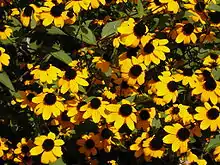Rudbeckia triloba
Rudbeckia triloba,[2] the browneyed or brown-eyed susan, thin-leaved coneflower or three-leaved coneflower,[3] is a species of flowering plant in the family Asteraceae with numerous, yellow, daisy-like flowers. It is native to the central and eastern United States and is often seen in old fields or along roadsides. It is also cultivated as an ornamental.
| Rudbeckia triloba | |
|---|---|
 | |
| Scientific classification | |
| Kingdom: | Plantae |
| Clade: | Tracheophytes |
| Clade: | Angiosperms |
| Clade: | Eudicots |
| Clade: | Asterids |
| Order: | Asterales |
| Family: | Asteraceae |
| Genus: | Rudbeckia |
| Species: | R. triloba |
| Binomial name | |
| Rudbeckia triloba | |
Description
Rudbeckia triloba is a biennial or short-lived perennial herbaceous plant that grows to a height of 5 ft (150 cm) with a spread of up to 2.5 ft (75 cm). The primary stem has numerous branches, giving the plant an open, bushy appearance. The stems and branches are hairy and medium green, sometimes with a reddish color. The leaves are also hairy. The basal leaves have three lobes (hence The Latin specific epithet triloba).[4] The stem leaves are alternate and can vary in shape, from three-lobed, generally toward the bottom of the stem, to unlobed, higher up on the central stem and on the secondary branches. The three-lobed stem leaves are up to 7 in (18 cm) long and 4 in (10 cm) wide, and the unlobed leaves are up to 3 in (8 cm) long and 1 in (3 cm) wide.[5]
One or two flower heads measuring 0.5–1.5 in (1–4 cm) appear at the end of individual upper stems. Each flower head has six to twelve bright yellow ray florets surrounding a purplish brown flattened cone of disk florets. The flower heads are abundant and showy, although they have little or no scent.[6][7]
Similar species
R. triloba can be differentiated from similar species in a number of ways. Compared with Rudbeckia hirta, R. triloba is taller with smaller, more numerous flowers, and the leaves of R. hirta are unlobed with a fuzzy upper surface.[5] Compared with Rudbeckia laciniata, R. triloba is shorter and has fewer lobed leaves.[6]
Distribution and habitat
R. triloba is native in the United States from Utah to the west, Texas and Florida to the south, Minnesota to the north, and Massachusetts to the east.[1] Habitats include disturbed areas, woodland borders, thickets, rocky slopes, and alongside roads and railways.[7]
Uses
Cultivation
R. triloba is widely cultivated in gardens and is easy to grow when provided with full sun and moist soil. Spent flowers should be removed to encourage additional bloom, prevent any unwanted self-seeding, or both.[7][8]
In cultivation in the UK, Rudbeckia triloba has gained the Royal Horticultural Society’s Award of Garden Merit.[9][10]
See also
References
- "NatureServe Explorer 2.0". explorer.natureserve.org.
- USDA, NRCS (n.d.). "Rudbeckia triloba". The PLANTS Database (plants.usda.gov). Greensboro, North Carolina: National Plant Data Team.
- "Rudbeckia triloba". Germplasm Resources Information Network. Agricultural Research Service, United States Department of Agriculture.
- Harrison, Lorraine (2012). RHS Latin for Gardeners. United Kingdom: Mitchell Beazley. ISBN 184533731X.
- "Know Your Natives – Brown-Eyed Susan". Arkansas Native Plant Society. 19 August 2016.
- "Brown-Eyed Susan (Rudbeckia triloba)". www.illinoiswildflowers.info.
- "Rudbeckia triloba page". www.missouriplants.com.
- "Rudbeckia triloba - Plant Finder". www.missouribotanicalgarden.org.
- "RHS Plantfinder - Rudbeckia triloba". Retrieved 11 October 2018.
- "AGM Plants - Ornamental" (PDF). Royal Horticultural Society. July 2017. p. 93. Retrieved 11 October 2018.
 Media related to Rudbeckia triloba at Wikimedia Commons
Media related to Rudbeckia triloba at Wikimedia Commons
